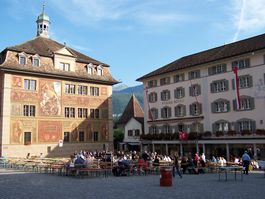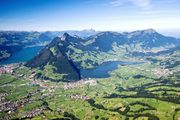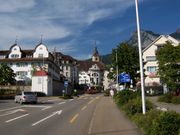Schwyz
| Schwyz | ||||||||||
|---|---|---|---|---|---|---|---|---|---|---|
 |
||||||||||
|
||||||||||
| Population | 14,243 (Dec 2009)[1] | |||||||||
| - Density | 268 /km2 (694 /sq mi) | |||||||||
| Area | 53.17 km2 (20.53 sq mi) | |||||||||
| Elevation | 516 m (1,693 ft) | |||||||||
| Postal code | 6430 | |||||||||
| SFOS number | 1372 | |||||||||
| Mayor | Beat Bürgler | |||||||||
| Localities | Schwyz, Ibach, Seewen, Rickenbach | |||||||||
| Surrounded by | Alpthal, Illgau, Ingenbohl, Lauerz, Morschach, Muotathal, Oberiberg, Rothenthurm, Sattel, Steinen | |||||||||
| Website | www.schwyz.ch SFSO statistics |
|||||||||
 Schwyz
|
||||||||||
| View map of Schwyz | ||||||||||
The town of Schwyz (French: Schwyz, Italian: Svitto) is the capital of the canton of Schwyz in Switzerland.
The Federal Charter of 1291 or Bundesbrief, the charter that eventually led to the foundation of Switzerland, can be seen at the Bundesbriefmuseum.
Contents |
History of the toponym


The name Schwyz is first attested in 972 as the village Suittes and is perhaps related to Old High German suedan "to burn", referring to the area of forest that was burned and cleared to build[2]. The name was extended to the area dominated by Schwyz (the Canton of Schwyz), and later to the entire Old Swiss Confederacy. Other cantons tended to resent this in the 15th century, but after 1499 the term Schwyzer was widely self-adopted, out of spite so to speak, since it had been employed as a term of abuse by the Swabian side during the Swabian War. Eidgenossenschaft and Schwytzerland could be used interchangeably as country names in the 16th century. Today, Swiss-German people use the name "Schwiiz", derivated from Schwyz as the Swiss name of the country. Most famous is the sentence "Hop Schwiiz", which most Swiss people yell in an international soccer game.
Geography
Schwyz has an area, as of 2006[update], of 53.2 square kilometers (20.5 sq mi). Of this area, 46.4% is used for agricultural purposes, while 39.1% is forested. Of the rest of the land, 8.7% is settled (buildings or roads) and the remainder (5.8%) is non-productive (rivers, glaciers or mountains).[3]
Demographics
Schwyz has a population (as of 31 December 2009) of 14,243.[1] As of 2007[update], 15.6% of the population was made up of foreign nationals.[4] Over the last 10 years the population has grown at a rate of 4.2%. Most of the population (as of 2000[update]) speaks German (90.1%), with Serbo-Croatian being second most common (2.7%) and Italian being third (2.0%).[3]
As of 2000[update] the gender distribution of the population was 49.9% male and 50.1% female. The age distribution, as of 2008[update], in Schwyz is; 3,537 people or 25.6% of the population is between 0 and 19. 4,144 people or 30.0% are 20 to 39, and 4,172 people or 30.2% are 40 to 64. The senior population distribution is 1,073 people or 7.8% are 65 to 74. There are 633 people or 4.6% who are 70 to 79 and 243 people or 1.76% of the population who are over 80. There are 3 people who are over 100 years old in Schwyz.[4]
As of 2000[update] there are 5,338 households, of which 1,582 households (or about 29.6%) contain only a single individual. 391 or about 7.3% are large households, with at least five members.[4]
In the 2007 election the most popular party was the SVP which received 39.9% of the vote. The next three most popular parties were the CVP (26.1%), the SPS (17.1%) and the FDP (12.7%).[3]
The entire Swiss population is generally well educated. In Schwyz about 66.4% of the population (between age 25-64) have completed either non-mandatory upper secondary education or additional higher education (either University or a Fachhochschule).[3]
Schwyz has an unemployment rate of 1.15%. As of 2005[update], there were 510 people employed in the primary economic sector and about 183 businesses involved in this sector. 2,838 people are employed in the secondary sector and there are 190 businesses in this sector. 6,394 people are employed in the tertiary sector, with 692 businesses in this sector.[3]
From the 2000 census[update], 11,269 or 81.6% are Roman Catholic, while 751 or 5.4% belonged to the Swiss Reformed Church. Of the rest of the population, there are 7 individuals (or about 0.05% of the population) who belong to the Christian Catholic faith, there are 423 individuals (or about 3.06% of the population) who belong to the Orthodox Church, and there are less than 5 individuals who belong to another Christian church. There are 5 individuals (or about 0.04% of the population) who are Jewish, and 502 (or about 3.64% of the population) who are Islamic. There are 80 individuals (or about 0.58% of the population) who belong to another church (not listed on the census), 377 (or about 2.73% of the population) belong to no church, are agnostic or atheist, and 385 individuals (or about 2.79% of the population) did not answer the question.[4]
The historical population is given in the following table:[5]
| year | population |
|---|---|
| 1950 | 10,259 |
| 1960 | 11,007 |
| 1970 | 12,194 |
| 1980 | 12,236 |
| 1985 | 12,378 |
| 1990 | 12,723 |
| 2000 | 13,825 |
| 2005 | 14,302 |
| 2007 | 14,186 |
Weather
Schwyz has an average of 149.2 days of rain per year and on average receives 1,629 mm (64.1 in) of precipitation. The wettest month is August during which time Schwyz receives an average of 199 mm (7.8 in) of precipitation. During this month there is precipitation for an average of 13.9 days. The month with the most days of precipitation is June, with an average of 14.8, but with only 182 mm (7.2 in) of precipitation. The driest month of the year is February with an average of 99 mm (3.9 in) of precipitation over 13.9 days.[6]
References
- ↑ 1.0 1.1 Swiss Federal Statistical Office, MS Excel document – Bilanz der ständigen Wohnbevölkerung nach Kantonen, Bezirken und Gemeinden (German) accessed 25 August 2010
- ↑ Room, Adrian. Placenames of the World. London: MacFarland and Co., Inc., 1997.
- ↑ 3.0 3.1 3.2 3.3 3.4 Swiss Federal Statistical Office accessed 31-Aug-2009
- ↑ 4.0 4.1 4.2 4.3 Canton Schwyz Statistics (German) accessed 27 August 2009
- ↑ Schwyz in German, French and Italian in the online Historical Dictionary of Switzerland.
- ↑ "Temperature and Precipitation Average Values-Table, 1961-1990" (in German, French, Italian). Federal Office of Meteorology and Climatology - MeteoSwiss. http://www.meteoswiss.admin.ch/web/de/klima/klima_schweiz/tabellen.html. Retrieved 8 May 2009., the weather station elevation is 480 meters above sea level.
External links
- Municipality of Schwyz (German)
- Canton of Schwyz (German)
|
|||||||
|
|||||||||||||
